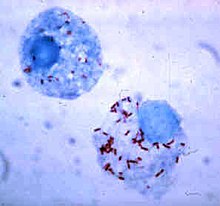Rickettsiales
| Rickettsiales | |
|---|---|

| |
| Rickettsia rickettsii (red dots) in the cell of a deer tick | |
| Scientific classification | |
| Domain: | Bacteria |
| Phylum: | Pseudomonadota |
| Class: | Alphaproteobacteria |
| Order: | Rickettsiales Gieszczykiewicz 1939 (Approved Lists 1980) |
| Families | |
| |
The Rickettsiales, informally called rickettsias, are an order of small
The Rickettsiales are difficult to culture, as they rely on living eukaryotic host cells for their survival.
Rickettsiales phylogeny
The Rickettsiales further consist of three known families, the Rickettsiaceae, the Midichloriaceae, and the Ehrlichiaceae. Most studies also support the inclusion of the Holosporaceae, but one study has challenged this view.[4] In that alternative, the Holosporaceae are the sole representatives of their own order, the Holosporales, and as such not part of the Rickettsiales (see the schematic tree below). Other lineages, not clearly part of any family, have been described, as well. Examples include Candidatus Arcanobacter lacustris [5] and Rickettsiales bacterium Ac37b.
| Schematic ribosomal RNA phylogeny of Alphaproteobacteria | ||||||||||||||||||||||||
| ||||||||||||||||||||||||
| The cladogram of Rickettsidae has been inferred by Ferla et al. [6] from the comparison of 16S + 23S ribosomal RNA sequences. |
Phylogenetic relationship between Rickettsiales and Pelagibacterales (SAR11)
The phylogenetic relationship between these two groups has yet to reach consensus in the scientific literature.
Early reports suggested that they represented sister clades to each other.[7][8] However, later studies suggested that this relationship is false and was due to a phylogenetic artefact, which artificially groups independent AT-rich and fast-evolving lineages (Rickettsiales and Pelagibacterales have both properties) together.[9][10] Upon correcting for this artefact, the Pelagibacterales form a sister clade to the Hyphomicrobiales, Rhodobacterales and Caulobacterales instead.
Another study
Reductive evolution
Rickettsiales genomes are undergoing reductive evolution and are typically small (generally < 1,5 Mbp), AT-rich (generally < 40% GC) with a low coding density (generally < 85%) and a relatively high number of pseudogenes.[11] Reduction in genome size, % GC and coding density and genes are generally attributed to genetic drift and Muller's ratchet. Genetic drift is enhanced in Rickettsiales genomes due to low population sizes (given their endosymbiotic nature) and frequent population bottlenecks. Similarly, Muller's ratchet is activated through the lack of recombination and horizontal gene transfer (the eukaryotic host cell is a natural barrier).
References
